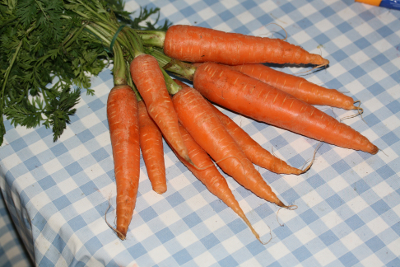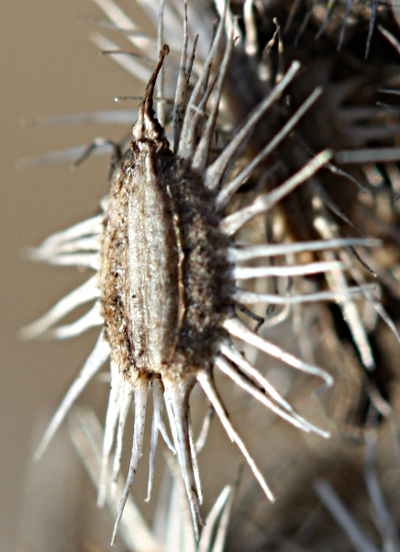Wild carrot |

Bunch of carrots

The fruits of wild carrot are provided with spiny ribs
Unlike many other white flowering umbelliferous, the wild carrot is very easy to recognize. In the center of the umbel a blackish or reddish flower occurs, which is shaped spherically and slightly larger. It is sterile, that is, it does not form fruits. Nevertheless, it has a function: In the eyes of an insect the black dot looks like a beetle or a fat fly, and where already other insects are, there are probably nectar and pollen. For this reason, the black flower is called "fake insect".
Carotenes
Named after the scientific name of the carrot, the carotene, especially the ▀-carotene, is a chemical precursor of vitamin A, which can be enzymatically converted into this. Vitamin A is found in animal products, including eggs and milk, and can be ingested and used directly. Only vegans have to meet their requirements of vitamin A with ▀-carotene.
Vitamin A is a generic term for various chemical compounds possessing different functions in the organism. So, retinal mediates signals in rhodopsin (visual purple) and retinoic acid has influence on growth factors, by increasing the number of receptors. In addition, it should be involved in gene expression.
Historical publications
Dioscorides (1st century AD.) wrote about the wild Staphylinos, the Romans would call it Carota or Pastinaca. The umbel would resemble the dill, but in the middle a purple structure would be located. The finger-thick root could be eaten when cooked. Seeds boiled as tea promoted menstruation and would help against dropsy and urinary retention. In addition, after application, one would not bitten by venomous animals. The tame Staphylinos, i.e. the ancestor of our cultivated carrot, was suited better for consumption, but it would have weakened healing effects.
Hildegard of Bingen (1098–1179) reported by "Morkrut", it was a refreshment for the people. It would neither hurt nor profit, but it would fill the stomach.
Leonhart Fuchs (1501–1566) designated carrots as parsnips. The fact that he actually described carrots, can be seen with reference to the illustrations and the descriptions. Fuchs knew two kinds of "tame parsnips", a yellow and a red variety.
The wild carrot had rough stems and leaves, which are divided as in the chervil. It would bear white flowers, in which one can recognize a single, button-shaped, purplish floret. The seeds were covered with small spines. The umbel would fold in like a bird's nest. The plant would possess a finger-thick root that would correspond in their fragrance to the cultivated carrot.